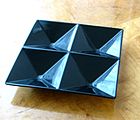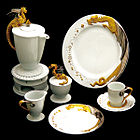- Tableware
-
Tableware is the dishes or dishware (ceramic), dinnerware (ceramics and other materials), or china (porcelain) used for setting a table, serving food, and for dining.[1] Tableware can be meant to include flatware and glassware. The nature, variety, and number of objects varies from culture to culture, religions, and cuisines.
In Britain and in the United States, tableware is most commonly referred to as dinnerware. Dinnerware can be meant to include glassware, however not flatware. In Britain, the term crockery is sometimes used for ceramic dishes. In the USA, ceramic dinnerware, whether made of porcelain or earthenware, is often referred to as china. Sets of dishes are often referred to as a table service or service set. Table settings or place settings are the dishes, flatware (cutlery), and glassware used by an individual for formal and informal dining. In the United Kingdom, silver service or butler service are names of methods for serving a meal.
Contents
History
The first known use of the term tableware was in 1766, dinnerware in 1895, and dishware in 1946.[2]
Dining culture in the United States
In 1880, Victorianism had established itself in the United States, with middle class Americans enjoying the materialism and consumption of goods to express their identities. The dining room or dining parlor, which had been in upper class houses since the colonial period of American history, became more common in middle-class homes. Dining became a social event with various food dishes being served with various manufactured tableware shapes. "The tools used for social dining changed dramatically over time, reflecting both changes in social life and the development of a tableware "fashion system." The manufacturers and marketers of china and glass wanted to sell more goods, the authors and publishers of books on entertaining sought to sell more copies; and the editors of tastemaking magazines pursued greater circulation and advertising revenues. They made table setting a distinctive fashion system of its own."[1]
From 1920 to 1945, the United States saw the onset of casual dining as processed foods and changing food habits appeared. Women spent less time cooking. Casseroles, food dishes made with canned soups, etc., became popular and tableware makers added a new dish, the casserole dish, to their products lines. "Under the new regime of simplicity the well set table displayed the least number of pieces possible."[1]
From 1945, after World War II, to 1960, the kitchen, no longer limited to the place where food was prepared, became a place to entertain and to dine with family and friends. Dinnerware sets were more informal in style, although a formal set of dinnerware or china was used for special occasions. After the 1960s until the 1980s, the formal dinner party returned as a "wave of gourmet culture"[1] swept the United States with the introduction of Julia Child's television program, Mastering the Art of French Cooking. However, the excess of Victorianism was replaced by simplicity in the number of shapes and pieces used for dining.
Dinnerware
Dishes are usually made of ceramic materials such as earthenware, stoneware, or porcelain, however can be made of other materials such as wood, pewter, silver, gold, glass, acrylic, and plastic. Dishes are purchased either by the piece or by set which include either four, eight, or twelve place settings.
Shapes
Place setting dishes
- Plates, such as service plates, dinner plates, lunch plates, desert plates, salad plates, or bread plates
- Bowls, including soup bowls, cereal bowls, fruit bowls, cream soups, or dessert bowls
- Individual covered casseroles or covered soups
- Teacups, coffeecups, and Demitasse cups
- Saucers, including teacup saucers, coffeecup saucers, demitasse saucers, and cream soup saucers.
- Mugs, coffee or tea mugs, and chocolate mugs.
Serving dishes
- Salt and pepper shakers, salt cellars
- Sugar bowl and creamer
- Teapot, coffeepot
- Butter dish
- Pitchers or Jugs: water, milk, juice, and syrup
- Serving bowls including vegetable bowls and salad bowls
- Casseroles or lidded serving bowls
- Sauce boats
- Platters including chop plates, salvers, and trays
- Tureen
- Tajine
Patterns (decoration)
See also Category: Types of pottery decoration.Notable designers
- Clarice Cliff, Britain
- Susie Cooper, Britain
- Rupert Deese, USA Franciscan Ceramics
- Edith Heath, USA
- Raymond Loewy, USA
- Frederick Hurten Rhead, Homer Laughlin
- Ben Siebel, USA Iroquois China
- Timo Sarpaneva, Finland
- Dorothy Thorpe, USA
- Bjorn Wiinblad, Denmark, Rosenthal Porcelain Manufacturer
- Susan Williams-Ellis, Britain Portmeirion Pottery
- Tapio Wirkkala, Finland
- Russel Wright, USA Iroquois China and Steubenville China
- Eva Zeisel, USA, Hall China, Red Wing Pottery and Castleton China
Manufacturers
Ceramics
For 18th-century European porcelain manufacturing companies and current porcelain manufacturers in Germany and other European countries, see Porcelain manufacturing companies in Europe.See also categories: Ceramics manufacturers, Ceramics manufacturers of the United Kingdom, Ceramics manufacturers of England, Staffordshire pottery, Ceramics manufacturers of Wales, Ceramics manufacturers of the People's Republic of China, Ceramics manufacturers of Denmark, Royal Copenhagen , Ceramics manufacturers of Germany, Ceramics manufacturers of the United Arab Emirates, and Ceramics manufacturers of the United States.- Castleton China, USA
- Faiencerie de Gien, France
- Fitz And Floyd, USA
- Hadley Pottery, USA
- Iroquois China, USA
- Kütahya Porselen, Turkey
- Rosenthal AG, Germany
- Steubenville China, USA
Glass
- Anchor Hocking, USA
- Baccarat, France
- Christofle, France
- Corning, USA
- Kosta Boda, Sweden
- Waterford Crystal, Britain
Silver and other metals
See also Category: Silversmiths by nationality.Glassware
Flatware
Gallery
Blanche, designed by Gertrud Lönegren, Sweden.Dragonware, Barbara Flügel Porzellan, Germany.Collections in museums
- Porcelain and faience museum in Zurich
- Dallas Museum of Art
References
- ^ a b c d Venable, Charles L. et al (2000). China and Glass in America, 1880-1980: From Table Top to TV Tray. New York: Harry N. Abrams. ISBN 0810966921.
- ^ "Merriam-Webster Dictionary". Encyclopedia Britannica Company. http://www.merriam-webster.com/. Retrieved 11 August 2011.
Porcelain China Chinese porcelain · Chinese export porcelain · Chinese influences on Islamic pottery
Types: Proto-celadon (16th century BCE) · Celadon (1st century) · Yue (2nd century) · Jingdezhen (6th century) · Sancai (8th century) · Ding (10th century) · Qingbai (12th century) · Blue and white (14th century) · Blanc de Chine (14th century) · Kraak (16th century) · Swatow (16th century) · Kangxi (17th century) · Famille jaune, noire, rose, verte (17th century) · Tenkei (17th century) · Canton (18th century)Korea Japan Europe French porcelain · Chinese porcelain in European painting
Types: Fonthill Vase (1338) · Medici (1575) · Rouen (1673) · Nevers · Saint-Cloud (1693) · Meissen (1710) · Chantilly (1730) · Vincennes (1740) · Chelsea (1743) · Oranienbaum (1744) · Mennecy (1745) · Bow (1747) · Nymphenburg Porcelain Manufactory (1747) · Plymouth (1748) · Worcester (1751) · Frankenthal Porcelain Factory (1755) · Sèvres (1756) · Derby (1757) · Wedgwood (1759) · Wallendorf (1764) · Etiolles (1770) · Limoges (1771) · Clignancourt (1775) · Royal Copenhagen (1775) · Revol (1789) · Herend Porcelain Manufactory (1826) · Zsolnay (1853)Technologies People Ehrenfried Walther von Tschirnhaus · Johann Friedrich Böttger · Francois Xavier d'Entrecolles · Dmitry VinogradovCollections British Museum (London): Asia Department / Percival David Foundation · Dresden Porcelain Collection · Gardiner Museum (Toronto) · Kuskovo State Museum of Ceramics (Moscow) · Musée national de Céramique-Sèvres (Paris) · Musée des Arts Décoratifs (Paris) · Palace Museum (Beijing) · Topkapı Palace (Istanbul) · Victoria and Albert Museum (London) · Worcester Porcelain MuseumBeer glassware Beer glassware 
Stemware Stemware 
Other glassware Other glassware 
Cuisine Outline Regional African · Americas · Arab · Asian · Caribbean · Central Asian · Eastern European · European · Sami · Latin American · Mediterranean · Middle Eastern · North African · South Asian · West African
National Afghan · Albanian · Algerian · American · Argentine · Armenian · Australian · Austrian · Azerbaijani · Bahraini · Bangladeshi · Belarusian · Belgian · Belizean · Beninese · Bhutanese · Bolivian · Bosnia and Herzegovina · Botswanan · Brazilian · British · Bulgarian · Burkinabe · Burmese · Cambodian · Cameroonian · Canadian · Chadian · Chilean · Chinese · Colombian · Congolese · Croatian · Cuban · Cypriot · Czech · Danish · Dutch · Ecuadorian · Egyptian · English · Equatorial Guinean · Estonian · Ethiopian · Filipino · Finnish · French · Georgian · German · Greek · Guatemalan · Honduran · Hungarian · Icelandic · Indian · Indonesian · Iranian · Iraqi · Irish · Israeli · Italian · Ivorian (Côte d'Ivoire) · Jamaican · Japanese · Jordanian · Kazakh · Korean · Kuwaiti · Lao · Latvian · Lebanese · Libyan · Lithuanian · Luxembourg · Macedonian · Malagasy · Malaysian · Maltese · Mexican · Moldovan · Mongolian · Moroccan · Native American · Nigerian · Nigerien · Norwegian · Omani · Pakistani · Palestinian · Panamanian · Peruvian · Polish · Portuguese · Qatari · Romanian · Russian · Salvadoran · Saudi Arabian · Scottish · Serbian · Sicilian · Singaporean · Slovak · South African · Spanish · Sri Lankan · Sudanese · Swazi · Swedish · Swiss · Syrian · Taiwanese · Thai · Tunisian · Turkish · Trinidad and Tobago · Ukrainian · United Arab Emirati · Uruguayan · Uzbekistan · Venezuelan · Vietnamese · Welsh · Yemeni
Historical Styles Cuisine classique · Fast food · Fusion · Haute cuisine · Immigrant · Modernist · Molecular gastronomy · Nouvelle ·
Types of food Confectionery · Dairy products · Fruit · Herbs / Spices · Meat · Vegetable
Carbohydrate staples Types of dish Technical See also Food portal · Drink portal
Wikimedia Foundation. 2010.









